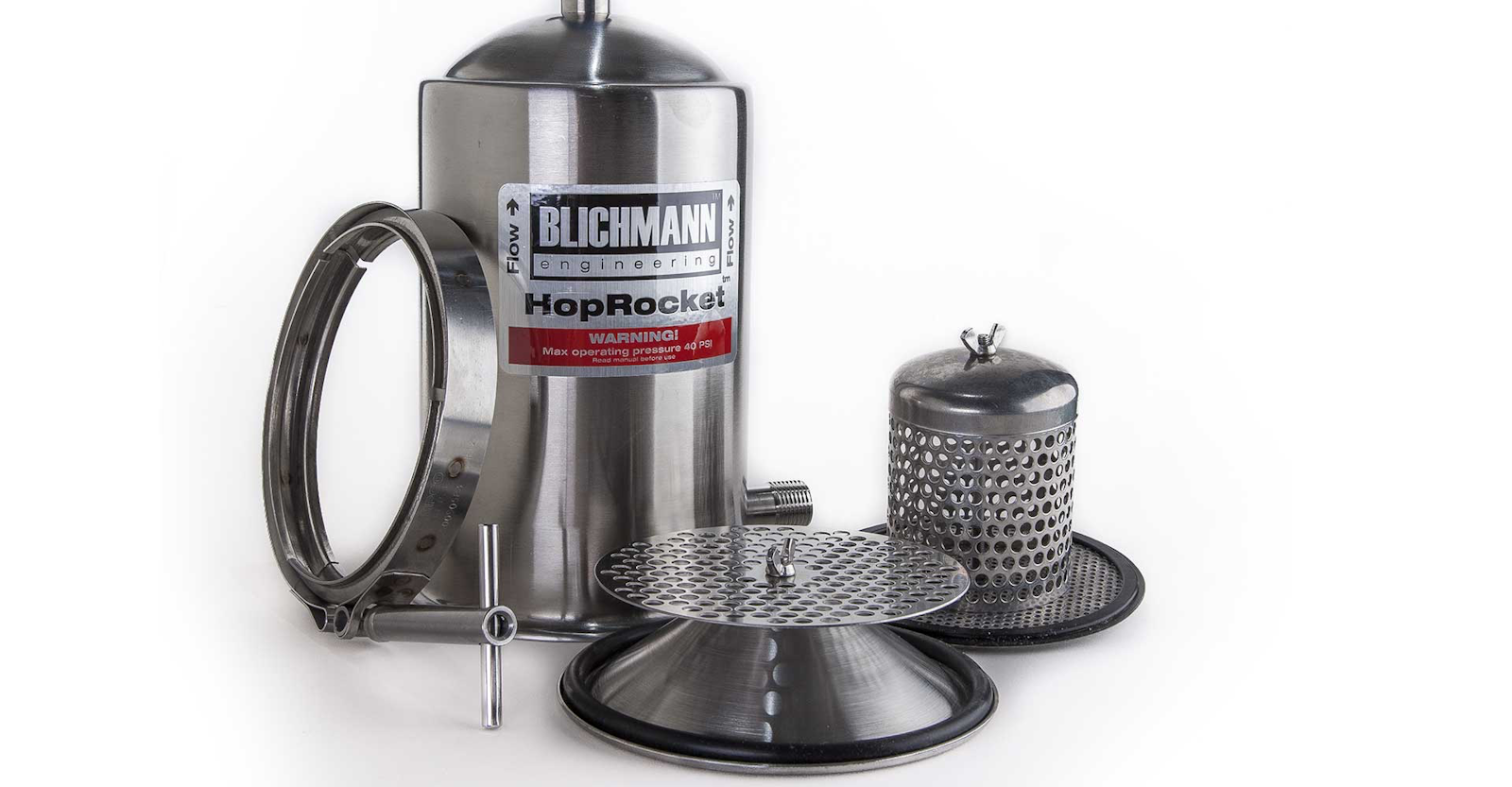What a hoppy world we live in! Hops-forward styles such as double IPAs and imperial Pilsners are pushing boundaries on both the craft side and in homebrewing, and extreme times call for extreme measures. Every step of the brewing process has become an opportunity to shoehorn in some more hops character. Very late hops additions (a hop stand or whirlpool hopping) offer a way to get more intense flavor and aroma because the essential oils are not boiled away. The hops are added after the knockout and given up to 60 minutes to offer their bounty. Many pro brewers rely on this for their IPAs, and homebrewers have leveraged the technique as well.
A hopback offers another variation on that idea. It’s a container packed with whole hops that the hot wort passes through before it’s chilled down. As with whirlpool hops, the wort can soak up the flavor and aroma, but there’s even less chance for loss because it’s completely sealed. As a bonus, the hops also act as a filter to trap hot break and trub, which can improve your beer’s clarity. There are a few commercial hopbacks available for homebrewers, with the Blichmann HopRocket the Blichmann HopRocket (pictured above) being one of the most well-known. These work perfectly well, but there’s nothing stopping you from making your own.
Design Tradeoffs and Parts
The key decision is what to use as the main body of the hopback. There are a number of options, from glass mason jars to stainless-steel storage containers. Personally, I prefer to minimize opportunities for breakage, so I recommend going with stainless-steel. Household shops such Bed Bath & Beyond offer a variety of sizes of stainless canisters that are designed for storing coffee or other foodstuff, which will work well for our purposes.
Another consideration is choosing the kind of connectors that will work well between your kettle and chiller. In the example below, I went with garden hose connectors so I could add quick-connect fittings compatible with my pump and chiller.
Parts List
- Large sealable, stainless-steel container
- 1 Stainless steel mesh sink strainer (that fits your canister)
- 1 3/4" (19 mm) female garden hose thread (GHT) to 1/2" (13 mm) male NPT
- 1 3/4" (19 mm) male GHT to 1/2" (13 mm) male NPT
- 2 1/2" (13 mm) I.D. silicone washers
- 2 1/2" (13 mm) I.D. flat washers
- 2 1/2" (13 mm) nuts
Tools
- Drill and normal drill bits
- Stepper drill bit (1/4"/6 mm to at least 1/2"/13 mm)
- Dremel tool with a grinder/polisher bit
Assembly
The assembly steps are fairly simple, but do require some technical skill. Take your time and be careful drilling the canister because it’s easy to warp or tear the metal.
Drill the Inlet and Outlet Holes
You’ll need to drill two holes. The inlet hole will be near the top, on the side, while the outlet hole will be centered in the bottom of the canister. For the inlet hole, make sure that the final hole will not interfere with the clasp mechanism for sealing the canister.
- In each case, start by drilling a 1/8" (3 mm) pilot hole at the center of where you want the larger hole.
- Next, switch to a 1/4" (6 mm) bit to expand the pilot hole. Work slowly; ramming the bit into the metal will likely mangle the thin steel.
- Use the stepper bit to slowly expand the hole to 1/2" (13 mm). You should be able to fit the NPT male side of the fittings through the hole.
- Use the Dremel to carefully clean the edges of the hole.
Mount the Fittings
Once you have the holes drilled, the next step is to mount the fittings.
- Start with the inlet fitting (3/4"/19 mm female GHT to 1/2"/13 mm male NPT).
- Place the fitting through the side hole near the top.
- Slide a silicone washer onto the fitting inside the canister, then add a flat washer.
- Screw the nut onto the pipe fitting and tighten.
- Repeat the process with the outlet fitting (3/4"/19 mm male GHT to 1/2"/13 mm male NPT) on the bottom of the canister.
If you want, you can attach quick connect fittings to the garden hose connectors outside the canister. If so, use plumber’s tape to seal the threads.
Using the Hopback
Using the hopback is easy:
- Sanitize the hopback and mesh strainer before use.
- Place the hopback in line between your kettle and your counterflow or plate chiller. Ideally, the hopback should be gravity fed directly from the kettle with a pump between the hopback and the chiller. A full-on gravity-feed setup would be very challenging.
- Place the sink strainer upside down at the bottom of the hopback over the outlet pipe.
- Put 1 to 3 ounces (28–85 g) of hops into the hopback.
- Slowly fill the hopback with wort from the kettle (don’t start the pump yet).
- When the hopback is almost full, close the lid and seal it.
- Start your pump. Watch the fluid level in the hopback. You might need to reduce the pump flow if it’s draining the hopback too quickly. If your canister has a transparent lid, you can see this. Otherwise, you can hear it suck air in around the lid.

